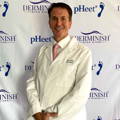WELLNESS IS TRENDING
Recent Scientific Breakthrough Reveals How To:
Say Goodbye To Dry, Cracked, and Flaky Skin On Your Heels and Feet
Published 24 October 2022
Many people in the United States have eczema, foot fungus, diabetes sores, or athlete's foot.
These are problems that are hard to fix and often ignored.
This can make people's feet feel itchy, dry, smelly, and cracked, which can be tough on their feelings and relationships.
People with these problems have often tried creams that don't work, and sometimes make the problem worse.
But this doesn't mean they have to suffer and give up!
Keep reading this report if you want to know how to put these struggles behind you using a scientifically proven solution made in the USA…
Plus, why A-list celebrities and world-class athletes with these problems are demanding access to this solution at any cost…
And how you can get your hands on it for just pennies a day!
Dr. John Swierzewski, a podiatrist and eczema patient, conducted a study that found the best way to hydrate and heal skin is to use a special pH level.

He then created pHeet® Foot Wipes with this pH level to help eczema and psoriasis patients.
These wipes are also effective against foot fungus and diabetic sores. GQ magazine rated pHeet® as the best antifungal foot wipes.
Our wipes are proven to:
- Stops itch and inflammation on feet and excema flares
- Refresh cracked & flaky skin on heels and feet
- Put an end to foot odor
pHeet® Foot Wipes will fight against eczema, athlete’s foot, diabetic issues, foot fungus, and so much more!
What other people are saying:


Disclaimer: This site is not a part of the Facebook website or Facebook Inc. Additionally, This site is NOT endorsed by Facebook in any way. FACEBOOK is a trademark of FACEBOOK, Inc.
Representations regarding the efficacy and safety of pHeet® have not been evaluated by the Food and Drug Administration. The FDA only evaluates foods and drugs, not health care products like these. They are not intended to diagnose, prevent, treat, or cure any disease. This information does not constitute medical advice and it should not be relied upon as such. Consult with your doctor before modifying your regular medical regime.
Scientific REFERENCES: 1. Kenichiro Chikakane, MD, Hisashi Takahashi, MD, PhDMeasurement of skin pH and its significance in cutaneous diseases, Clin in Dermatology.VOLUME 13, ISSUE 4, P299-306, JULY, 1995Clinics in Dermatology 2. Hans Christian Korting, MD, Otto Braun-Falco, MDThe effect of detergents on skin pH and its consequencesVOLUME 14, ISSUE 1, P23-27, JANUARY 01, 1996International Academy of Cosmetic Dermatology 3. F. BREIDT, JR., J. S. HAYES, AND R. F. MCFEETERSIndependent Effects of Acetic Acid and pH on Survival of Escherichia coli in Simulated Acidified Pickle Prod Jrnl of Food Protection, Vol. 67, No. 1, 2004, Pages 12–18 4. Alakomi, H. L., E. Dkytta, M. Saarela, T. Mattila-Sandholm, K. Latva-Kala, and I. M. Helander. 2000. Lactic acid permeabilizes Gram negative bacteria by disrupting the outer membrane. Appl. Environ. Microbiol. 66:2001–2005. 5. Breidt, F., J. S. Hayes, and H. P. Fleming. 2000. Reduction of microflora of whole pickling cucumbers by blanching. J. Food Sci. 65:1354–1358. 6. Brudzinski, L., and M. A. Harrison. 1998. Influence of incubation conditions on survival and acid tolerance response of Escherichiacoli O157:H7 and non-O157:H7 isolates exposed to acetic acid. J.Food Prot. 61:542–546. 7. Castanie-Cornet, M.-P., T. A. Penfound, D. Smith, J. F. Elliott, andJ. W. Foster. 1999. Control of acid resistance in Escherichia coli. J.Bacteriol. 181:3525–3535. 8. Diez-Gonzalez, F., and J. B. Russell. 1997. The ability of Escherichiacoli O157:H7 to decrease its intracellular pH and resist the toxicity 9. Mayerhauser, C. M. 2001. Survival of enterohemorrhagic Escherichia coli O157:H7 in retail mustard. J. Food Prot. 64:783–787. 10. McKellar, R. C., and K. P. Knight. 1999. Growth and survival ofvarious strains of enterohemorrhagic Escherichia coli in hydrochloric and acetic acid. J. Food Prot. 62:1462–1469.